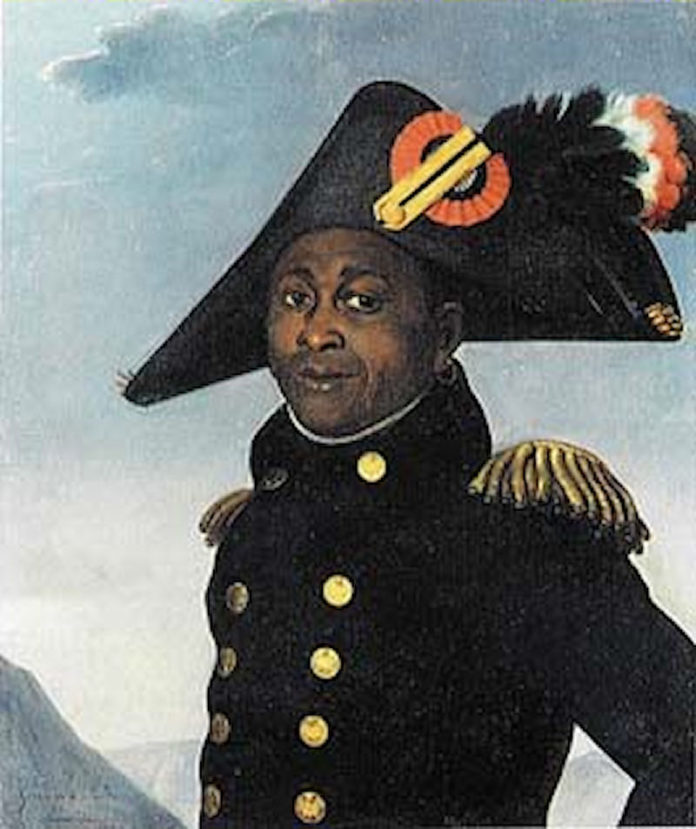
In 1789, the year of the French Revolution, Saint Domingue — now Haiti — was the richest colony in the world. The source of this wealth was the exploitation of half a million black slaves who furnished the labor for the sugar, indigo, cotton, cocoa, coffee, and tobacco extracted from over 2,000 plantations.
In principle, a series of royal edicts called the code noir (slave code) regulated the conduct of the white slave owners in France’s colonies. The code noir sanctioned corporal punishment, among other things, but in practice even this code’s few admonitions to feed, clothe, and refrain from raping one’s slaves went unenforced, and the plantation owners did as they wished. In fact many worked their slaves to death, since it was usually cheaper to buy than raise a slave. Hence the common proverb of colonialists of those days: “The Ivory Coast is a good mother.”
As a result of such barbarism and the enthusiasm for expanding the slave work force, although the first slave ships arrived at the island in 1510, even as late as 1789 two-thirds of the slaves in Saint Domingue were African-born.
Many thousands of black souls, some of whom had been warriors sold into slavery, disappeared into Haiti’s forests immediately on arrival to form communities of “negres marons” (runaway slaves).
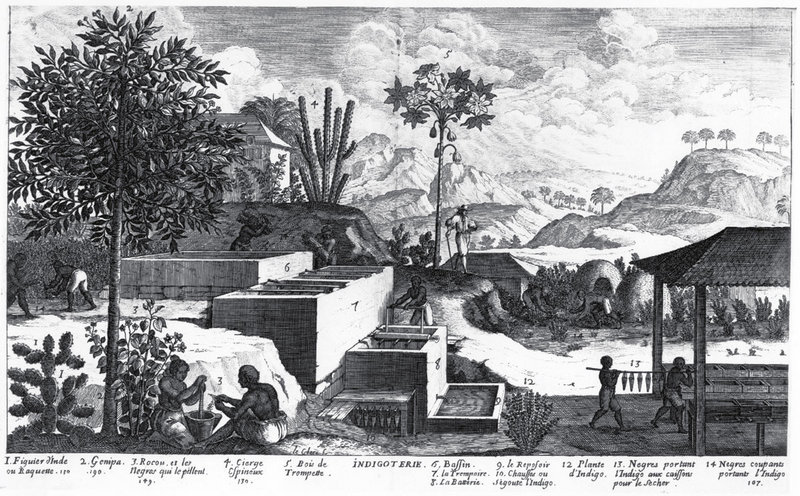
About 28,000 free blacks and mulattoes also lived in Saint Domingue at the time of the French Revolution, and most of them owned slaves. These property owners quickly became interested in what new rights they might extract from the Revolution because, compared to the French, their rights were radically curtailed.
As the spirit of the Enlightenment inflamed everyone, the Haitian slaves would prove to be those most faithful to its ideals. As Scottish/Irish revolutionary socialist James Connolly said: “None so fitted to break the chains as they who wear them. None so well equipped to decide what is a fetter.”
The Non-Violent Route: Struggle for Representation in the French National Assembly
Representatives of three groups went to France to request representation in the French National Assembly.
Black slaves. Not being permitted to represent themselves, the black slaves were represented by “the Society of the Friends of the Blacks.” This society initially promoted the abolition of slavery and wrote countless pamphlets opposing slavery and the slave trade. In the end, however, when it was accused of promoting a slave insurrection, the society denied that it had ever wanted to abolish slavery and defended itself by arguing that all it had ever wanted was to abolish new importation of Africans to the French colonies. So much for friendship.
Mulatto slave owners. The ultimate ambition of this group was to become white slave owners. Vincent Ogé, a wealthy planter and leader of the mulatto slave owners, presented his clan’s views to the white planter delegates. Unsatisfied with that meeting, in October 1790 he took part in a rebellion involving 350 mulattoes. The rebellion was squelched and Ogé was executed; however, on May 15, 1791, the National Assembly granted rights to “all free blacks and mulattoes who were born of free mothers and fathers,” in a decision so qualified that it affected only a few hundred people.
White plantation owners. The white planters began to grumble about taxation without representation and the possible advantages of independence. They refused to abide by the National Assembly’s ruling and concluded that this decision was the beginning of a move toward the emancipation of the slaves.
The Slave Revolt
On Aug. 22, 1791, Saint Domingue’s slaves rose up in what would ultimately become history’s first and only successful slave revolt. The initial rebellion was led by Vodou priest and maroon rebel leader Boukman. The slaves murdered their white masters by every possible means, trashed the towns and burned down the plantations. The scale of the attack was such that for three weeks ships could not approach the coast, and the smoke from the fires obscured day from night.
On Sep. 24, 1791, the French National Assembly responded to news of the revolt by rescinding the rights of free blacks and mulattos. The rebel leaders were caught and publicly tortured to death. Boukman’s severed head was put on public display. But even as another iteration of France’s parliament (in October 1791, the “National Assembly” replaced the “Legislative Assembly”) voted on March 28, 1792 to reinstate the political rights of free blacks and mulattos, and again decide nothing about slavery, the slaves were regrouping.
L’Ouverture
From the conflicts, a disciplined leadership emerged in Toussaint Breda, who later earned the name Toussaint L’Ouverture for being:
1) Toussaint – the one who raises all souls.
2) L’Ouverture – the one who finds the crack in the enemy’s defense and shows the way forward.
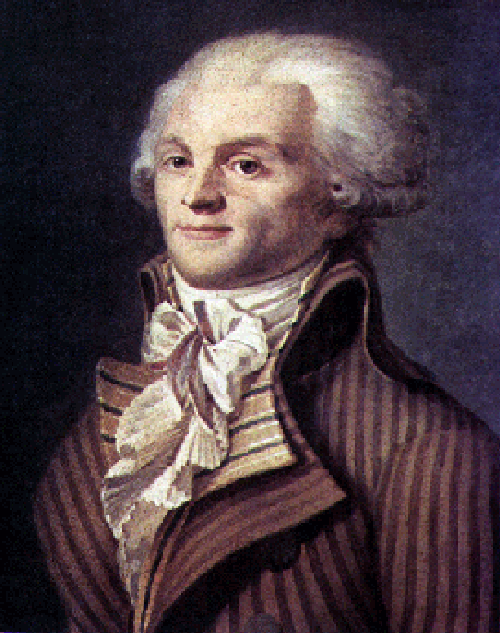
Toussaint L’Ouverture, born a slave in Saint Domingue in 1743 and self taught in many things, including military strategy, would ultimately drive huge battalions of the armies of Napoleon, the Spanish, and the British from the island of Hispaniola and guide Haiti to its independence.
The image above is thought to be the most authentic representation of Toussaint. Until recently, when one portrait was found that had been executed by Alexandre Francois de Girardin, there existed no authentic portrait of this remarkable man.
Toussaint is thought to have learned about Africa from his father, who may have been a tribal chief called Gaou-Guinou. Despite being a slave, Toussaint had been permitted to learn to read and write, and he taught himself to read French and Latin. His readings included Julius Caesar’s military writings. The notions of equality and liberty in the works of French Enlightenment thinkers like Jean-Jacques Rousseau also resonated well with Toussaint.
On the Breda Plantation, Toussaint worked as the overseer of livestock, a horticulturist, horse trainer, and coachman. According to Marcus Rainsford, one of the earliest chroniclers of the Haitian Revolution:
“Among other traits fondly preserved in St. Domingo of the conduct of Toussaint during the early period of his life, are his remarkable benevolence towards the brute creation, and an unconquerable patience…. He knew how to avail himself so well of the sagacity of the horse, as to perform wonders with that animal; without those cruel methods used to extort from them the docility exhibited in Europe; he was frequently seen musing amongst the different cattle, seemingly holding a species of dumb converse, which they evidently understood, and produced in them undoubted marks of attention. They knew and manifested their acquaintance, whenever he appeared…. The only instance in which he could be roused to irritation, was when a slave had revenged the punishment he received from his owner upon his harmless and unoffending cattle.”
Toussaint joined the revolution about 10 years after being freed from slavery at age 33. Soon after he took that momentous step, he helped his former master, M. Bayou de Libertas, escape to Baltimore, Maryland.
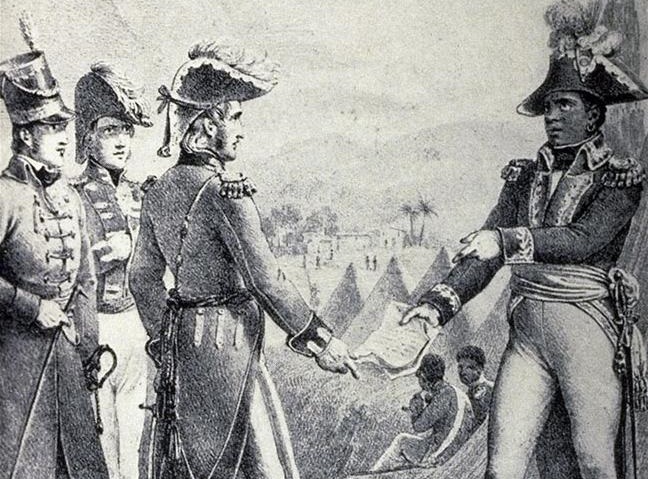
Toussaint’s military training began under the black leader Biassou, but Toussaint was soon appointed next in command and quickly given his own division. Initially, he trained a crack team of only a few hundred extremely well-disciplined revolutionaries.
In the fall of 1792, the French government sent emissaries to Saint Domingue to bring the slave revolt to heel. In response, Toussaint and the other rebel slave leaders struck agreements with the British and Spanish to fight with their armies against the French. If the British and Spanish merely viewed this as an opportunity to weaken France, so did the rebels.
By 1793, the French revolution was being steered by the Jacobins. This group, led by Maximilian Robespierre, is best known for the Reign of Terror campaign to rid France of the “enemies of the revolution.”
Though the Jacobins were ruthless, they were also purists who strived to push the ideals of revolution as far as they would go. And so it was they who formally voted to end slavery in the French colonies, including Haiti, when they took up the issue of equality. Specifically, after the Haitian slave rebellions and the slave-assisted invasions from the Spanish and British caused a near total collapse of Saint Domingue’s economy, the National Convention (of the Jacobin Assembly that succeeded the Legislative Assembly) agreed to hear a multiracial delegation from Saint Domingue describe the evils of slavery and then voted on Feb. 4, 1794 to end slavery in all France’s colonies. Saint Domingue’s mulattoes opposed this move almost as vigorously as the whites, who fled Saint Domingue by the thousands. In the end, however, the slave trade continued because this decree, like so many others, went unenforced.
Nevertheless, the Haitian slave rebels felt sufficiently encouraged by the Jacobin vote to offer to help the French army eject the British and Spanish from the island. By then Toussaint was leading 4,000 fighters. In January 1798, Haiti’s slave armies, guided by Toussaint’s brilliant military strategy, defeated a British army of 60,000 men in seven major battles over seven days and forced them off the island. Two years later, the slave army evicted the Spanish army from the eastern half of Hispaniola, now the Dominican Republic. By then, Toussaint commanded 55,000 experienced fighters.
Toussaint L’Ouverture soon became the de facto ruler of Haiti. As the country’s “colonial governor,” Toussaint began the even harder tasks of promoting reconciliation and rebuilding the war-ravaged economy. For example, compared to 1789, by 1800 production from the plantations had dropped by 80%.
According to Rainsford:
“Such was the progress of agriculture from this period, that the succeeding crop produced (notwithstanding the various impediments, in addition to the ravages of near a ten years war) full one third of the quantity of sugar and coffee, which had ever been produced at its most prosperous period…. Health, became prevalent throughout the country….”
Haiti’s first Constitution was written in 1801 under Toussaint’s rule. C. L. R. James best describes this document’s embodiment of the Enlightenment ideals:
“The Constitution is Toussaint L’Ouverture from the first line to the last, and in it he enshrined his principles of government. Slavery was forever abolished. Every man, whatever his color, was admissible to all employments, and there was to exist no other distinction than that of virtues and talents, and no other superiority than that which the law gives in the exercise of a public function.”
Enter Napoleon
For a while it looked as though Haiti would be allowed to continue as an independent state and a French colony in name only, but soon the French executed Maximilian Robespierre and returned to business as usual. Ultimately Napoleon Bonaparte managed a coup d’état and proclaimed himself emperor. He resolved to retake Saint Domingue for the French plantation owners and quietly dispatched a huge force to crush the slave revolt, reinstate slavery, and abolish the rights that had been granted to the free blacks. The French force wound up losing Napoleon’s brother-in-law, who was a reputed sadist, along with 24,000 soldiers. Due to the shame of being beaten by a bunch of “barefoot slaves,” the French formally attributed most their deaths to yellow fever.
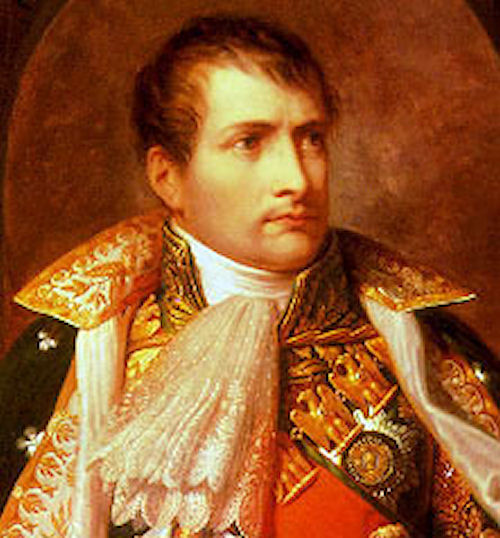
By 1803, Toussaint calculated that the defeats of Napoleon’s emissaries should have reasonably persuaded him to consider a peace accord. Toussaint’s offer was that he would retire from public life if Napoleon would recognize Haitian Independence. Within a few months, Toussaint was drawn into a trap: he was invited to a negotiation meeting and, on Napoleon’s orders, put on a boat to France.
On realizing his betrayal, Toussaint spoke these famous words to the ship captain: “En me renversant, ils n’ont abattu à Saint Domingue que le tronc de l’arbre de la liberté des noirs. Il repoussera par des racines parce qu’elles sont profondes et nombreuses.” (“In overthrowing me, they have only felled the trunk of the tree of black liberty in Saint Domingue [Haiti]. It will regrow from the roots because they are deep and many.”)
These words acquire greater meaning with every decade that passes and never fail to make me shiver. Now I can see Toussaint as a self-possessed man who fully knows his worth. He is saying here that Napoleon is deluding himself if he thinks he is decapitating the Haitian Revolution. Toussaint appreciates that he is supported from the grassroots: a concept that a top-down general like Napoleon could never grasp. In addition, Napoleon could not have understood that several other brilliant black commanders would continue the fight. Toussaint’s fatal mistake was to under-estimate Napoleon’s racism.
Thus on the orders of Napoleon, Toussaint was thrown into a dungeon in the Jura mountains in the French Alps. When the poet William Wordsworth learned about Toussaint’s news, he wrote the following sonnet:
….Live, and take comfort. Thou hast left behind
Powers that will work for thee; air, earth, and skies;
There’s not a breathing of the common wind
That will forget thee; thou hast great allies;
Thy friends are exultations, agonies,
And love, and man’s unconquerable mind.
Toussaint died of cold and starvation in Fort de Joux prison on Apr. 7, 1803.
The Struggle Continues
As Toussaint predicted, other Haitian revolutionaries continued the fight against slavery. At the Battle of Vertières on Nov. 18, 1803, the rebel army, now led by General Jean-Jacques Dessalines, conclusively devastated the French army led by Napoleon’s new emissary, Rochambeau.
Consequently, within months of killing Toussaint, Napoleon was forced to concede his loss of Haiti by giving up his other New World possessions. This included the sale of the French territory in North America to the United States: Thomas Jefferson’s Louisiana purchase.
Incidentally, Thomas Jefferson agreed to allow slavery in the newly acquired territory when U.S. Southerners pushed for it.
On Jan. 1, 1804, with the consummation of the first and only successful slave revolt in history, Haiti’s self-emancipated slaves declared “The Independent Republic of Hayti.”
Years later, during his exile at Saint Helena, when Napoleon was asked why he had behaved so dishonorably toward Toussaint. True to form, he replied: “What could the death of one wretched Negro mean to me?”
The present has a way of warping one’s perception of men, and it takes distance and perspective to measure them. Three centuries later, the despotic Napoleon is shrunk to size, and Toussaint continues to stand as the giant he always was.
C.L. R. James said it best: “Toussaint L’Ouverture was the finest product of that greatest period in human history: The Age of Enlightenment.”
This article was first published by Dady Chery on her blog Haiti Chery. She is a journalist, playwright, essayist, poet, and author of We Have Dared to Be Free: Haiti’s Struggle Against Occupation.
Background: The Black Jacobins, Toussaint and the San Domingo Revolution (1963), by CLR James | An Historical Account of the Black Empire of Hayti (1805), by Marcus Rainsford









